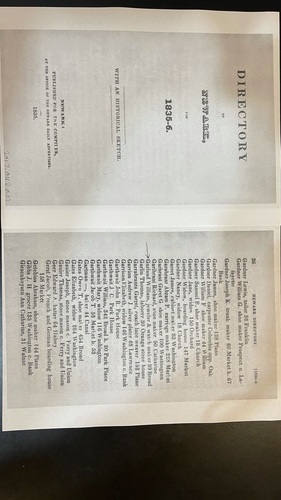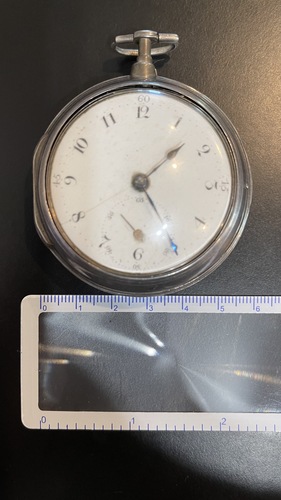by Richard Procter, London
Unknown


Hello Lance,
Thank you for sending in this most interesting pocket watch to mearto.com for an appraisal. I shall try to help you with that today.
TITLE:
Gent’s, Sterling silver, key wound and key set, verge escapement with chain driven fusee, pair case, open face pocket watch, Serial number 8009, made and signed by Richard Procter (Proctor), London, made in England circa 1795.
DESCRIPTION:
Outer case: Measuring approximately 55mm in diameter this is a Sterling silver outer case (of a pair cased watch) with the inside of the back cover having English hallmarks with the Lion Guardant (Sterling silver), the Leopard head wearing a crown (the London Assay office prior to 1822), the lower case letter, ‘u’ (Date Letter mark for 1795), the I.R mark for the casemaker James Richards at 9 Bridgewater Square, London (in business as a silversmith and watch case maker from circa 1762-1822 in London). The image of King George III looking towards the right indicates that a Duty tax was paid to the English Crown on this watch (used King George III mark from 1786-1821). Also inside the case are two watch papers. These American watch papers represent either the retailing of the watch in America or repair work done on the watch here in the USA. It was first handled in New York City by Whitney & Griffen, clock and watch makers in downtown New York City. My best guess is that this English made watch was exported to NYC and was sold by the Whitney & Griffen firm. (They are listed as being in business circa 1799 in NYC.) The second watch paper is that of William Garland of Newark, N.J., working as silversmiths, jewelers and doing clock and watch repair and we know this firm is listed in newark in 1835/36, since you supplied the documentation. I imagine this watch paper is included for repair work done several years later.
Inner case: Measuring 50 mm in diameter, this silver open face, key wound and key set pocket watch has a long stemmed round but flat silver pendant and arched bow placed at the twelve position relative to the dial. The back cover is not pictured, but is silver whether or not it bears any hallmarks. This inner case was made in Great Britain.
Dial: This is a round white enameled dial with black radial Arabic hours, open dotted minute track with Arabic numerals placed every fifteen minutes around the minute ring. There is a subsidiary continuous seconds’ dial @6 and Continental style, blued steel, Spade hands. The minute hand tip has been cut and that suggests that the minute hand has been replaced at some point. The dial is unsigned.
Movement: This is a key wound and set, double brass plate movement (called the dial plate and the back plate) which is connected by brass pillars (not shown) and most likely is powered by a chain driven fusee spring. This is likely accompanied by a verge escapement (not shown). What is shown is the back plate with its fine round and fenestrated balance cock (aka-balance bridge) which sits above the balance wheel. The bridge has a lacey or knurled edge and is engraved with scrolling foliate ornaments centered by a single rosette. Near the step down footing is an engraved grotesque mask. Such masks were used and embellished during the entire 18th century in English watch making. Helping to properly date this movement is the width of the engraved foot. Note that the width of the stepped down foot, at its widest point is less in diameter than the diameter of the round balance bridge. That suggests an English movement made toward the latter part of the 18th century. Adjacent to the balance is the silvered regulator with Arabic markers and this regulator is used to make the movement run faster or slower. Note the hand with its index finger pointing to the regulator, a typical English touch. The back plate is signed in script, “Rich. Procter” and in print, “London”. The listed S/N is 8009
Unfortunately, he is not listed in any text that I can locate, nor online. However, there are many unidentified watchmakers and casemakers that have not yet been listed in textbooks. However, I was able to find a Richard Proctor, London pocket watch that was sold at auction in 2009, but barely described by the auctioneer. SEE:
https://www.barnebys.com/realized-prices/lot/richard-proctor-london-a-gentleman-s-pocket-watch-qcPbVYJDcN
This watch was sold at Dreweatts Auction in the United Kingdom. To me it proves that such a person existed in London circa 1800.
CONDITION:
Case – Although I cannot see all of the covers the general condition of this pair cased watch is fair to good.
Dial – Unfortunately there is a dial fracture running from the base of the hands through to the 40 minute marker. Scattered speckles of mold.
Movement – this appears to be in very good condition, clean and possibly functional.
COMPARABLES:
https://www.liveauctioneers.com/item/80890530_two-early-english-pocket-watches-in-silver (SOLD IN 2020 FOR $250)
https://www.liveauctioneers.com/item/82194332_an-antique-silver-pair-case-pocket-watch (SOLD FOR $150 IN 2020)
https://www.liveauctioneers.com/item/92732349_english-pair-case-pocket-watch (SOLD FOR $258 IN 2020)
https://www.liveauctioneers.com/item/71371645_wm-bold-42mm-7j-fusee-no-218-pair-pocket-watch (SOLD FOR $180 IN 2019)
PRICING:
If your watch was in very good condition it would sell in the $250-$300 range at auction today. Having the severe crack on the dial reduces that value by about 40% to $150-$180 for its fair market value. Well, at least you understand more about this old key wound, pair case pocket watch. The English actual not only made pair cased watches, but triple and quadruple cased pocket watches. Some outer cases are covered in tortoiseshell or leather. The purpose of the covering and the extra cases was for protection of the movement since many of these watches were exported to Asia and the Turkish market where there are vast stretches of desert and it would protect the mechanism from sand storms. Hope you enjoy reading the appraisal and I certainly enjoyed doing it for you. I thank you for your assistance in getting it done properly.
Thank you for choosing mearto.com for the appraisal.
My best,
David
Hi Lance,
Thank you for contacting Mearto with your appraisal inquiry.
Can you photograph the movement by opening the back of the inner case?
What is the diameter of the inner and the outer cases?
Thank you,
David
Please log in to your Mearto account to contact this seller or make an offer on this item.







